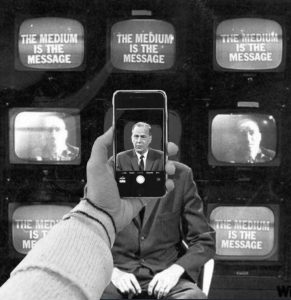If you got this far past the title, you’re either a techie, or really bored, or both. But I think it’s a really important juxtaposition in understanding the current state of things.
Marshall McLuhan coined the term “The medium is the message” in the 1960’s book Understanding Media: The Extensions of Man. I haven’t read this book yet, although I’ve ordered it. I have watched a few of his interviews.

McLuhan’s point was that the overall effect of a communication medium is far more important that the specific message conveyed. The effect of television on humanity is for more important than a television show. An example I can think of from my generation is that MTV’s effect on youth was not so much based on the content, but on the overall effect of television’s ability to capture the attention of people our age and change our thoughts and values.
This thought emerged from the primordial ooze of electronic communication in the 1960’s. How profound is the message today? Just look around at people staring at their phones, or the number of phones hoisted in the air during a concert. Is what the people recording or reading nearly as important as the effect the smart phone has had on everyone? I look forward to reading more of McLuhan’s work.

Photo: Jill Evans
I have personally found this assertion directly observable in the creation of this blog. Even after 2-3 blog entries I’m experiencing an increase in wonder and learning that I had back 20 years ago when the blog concept first manifested. This form of electronic medium seems to have a positive effect on me, at least.
So to connect dots with McLuhan, I am delving into my own related theory of tech with this blog: The intent of the creator, and values of the creator, have significant effect on the capabilities of a created technology. And further, if we understand the intent and values of the people who created the technology we can apply this info in ways that help us fulfil our own goals. This seems obvious but hopefully I’ll demonstrate that it isn’t always obvious. (It’s probable that none of this is original thought. I just haven’t found it illustrated anywhere else yet.)

The 3rd critical idea that enters this arena is the Open Systems Interconnection (OSI) model. The OSI model is a conceptual model that helps design and explain interoperability between systems. It is a good way of separating and identifying the technologies that are a part of nearly every aspect of our lives ‘these days’.
Because the OSI model describes 7 layers of communication medium, we can use it in concert with the prior concepts to start to figure out what happened, what’s currently going on, and where it can all lead. We can do this at all 7 levels. (And I’ll argue that there’s an 8th.)
Let’s squish all this together. We can parse the building blocks of our electronic experience using the OSI model. We can then use some of McLuhans ideas to analyze the effect of each of these aspects. We can also look at the intent and values of the creation/creators to gain further insight into how the mediums can be implemented or re-implemented.
Maybe we can identify some of the negative things happening, and come up with ways to fix them.
